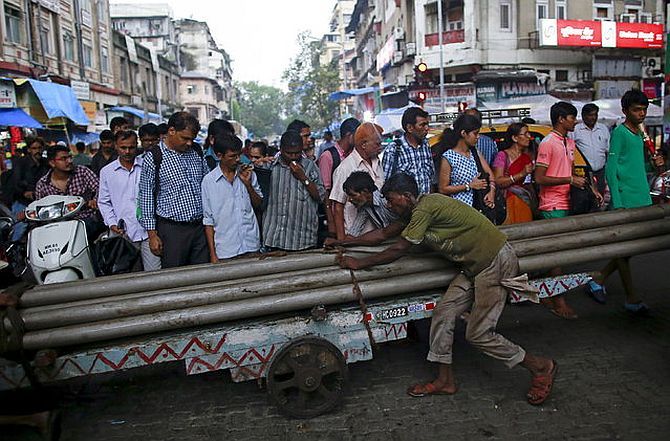 | « Back to article | Print this article |
A package that comprises reform of domestic subsidies and redirecting subsidy savings to expenditure that reaches the poor and intended beneficiaries may be used to drive policy reform, says Rahul Khullar in the first of a two-part series.

The silly season (because of Bihar) is coming to a close. And, the next one is a year away.
Time to get back to the grind on domestic policy reform.
Why? First, in today’s global economic climate, no country is going to export its way out of trouble.
We have to look within, namely, at the domestic real sector.
Second, there is little room for manoeuvre on the fiscal and monetary fronts.
For instance, cutting Plan outlays for a third year in a row is not an option.
Third, India needs to walk the talk to signal abiding credible commitment to reform.
Last, much of what needs to be done is well known. Inaction is no longer justifiable.
It is now imperative to move beyond general exhortations to specifics of reform. Since big-bang reforms are political anathema, gradualism reigns.
And, it has worked. Recall how milk prices have been raised in small increments without any hullabaloo.
Incrementalism also worked with diesel.
This piece proposes a package comprising: (a) specific reform of subsidies (fertilisers, kerosene, LPG and food, in that sequence), and; (b) redirecting subsidy savings to expenditure that better reaches the poor and intended beneficiaries and upgrades rural infrastructure.
This piece is organised in two parts: First, fertilisers and then, end-consumer goods.
Fertilisers: The subsidy is Rs 73,000 crore per annum (excluding arrears). Roughly Rs 50,000 crore is on account of urea (N) and Rs 23,000 crore on phosphate (P) and potash (K).
This is not a subsidy for the poor or others at the bottom of the pyramid. True, some of it reaches small holders. However, kulak farmers corner most of it.
The vast numbers of landless receive precisely nothing.
The unintended outcomes have been (a) subsidy to foreigners — smuggling across national boundaries is commonplace, and (b) soil degradation — under-pricing leads to general overuse of chemical fertilisers; and, when relative prices are out of kilter, the problems of the N-P-K balance are exacerbated.
Past efforts at raising prices have been stymied, mostly by our public representatives.
The opposition is couched in terms of the impact on poor farmers and the poor in general. It is no coincidence that many of our MPs are large landholders. Some reform has occurred.
In April 2010, there was a transition to a nutrient-based subsidy (NBS) regime.
This was okayed for P and K but not for N.
The result: between 2010 and 2015 prices of phosphates rose 150 per cent and potash 275 per cent. In stark contrast, urea prices increased from Rs 4,830 per tonne to Rs 5,360 per tonne — a paltry 10 per cent over five years.
This has led to a worsening of the N-P-K balance. In short, the urea subsidy must be addressed on priority.
The urea subsidy regime is complicated. First, there are plant-based production subsidies.
Second, there is a maximum retail price (MRP) at which urea can be sold. Conceptually, the subsidy comprises two parts — the subsidy directly accruing to producers; and the difference between the cost of production (net of production subsidy) and the MRP.
The MRP (Rs 5,360) is 29 per cent of the international prices at present, implying an effective subsidy of 71 per cent. A large upfront hike is now an imperative.
The proposal: immediately increase MRP to Rs 7,500 per tonne; increase MRP by 25 paisa per kg every month starting April 1, 2016; reduce plant-based subsidies steadily to halve the gap between domestic costs and international prices by April 1, 2018.
The international prices of P and K are $460 and $300 per tonne respectively. The subsidy is Rs 12,350 per tonne (P) and Rs 9,300 per tonne (K).
That is, a subsidy of 40-45 per cent on international prices. The proposal: reduce subsidy on P to Rs 11,000 and on K to Rs 8,000 per metric tonne immediately; reduce the subsidy (on P and K) by 25 paisa per kg per month starting April 1, 2016. The subsidy on potash was cut by 20 per cent in 2013: a reduction is, therefore, doable.
Come to kerosene. The total subsidy is Rs 14,000 crore. Of this, Rs 8,000 crore is borne by the central government. Upstream suppliers fork out Rs 5,000-6,000 crore.
This is not a subsidy for the poor. Less than two per cent of the subsidy reaches the poor; what little does is used for lighting, not fuel. Most of the kerosene is used as adulterant, enriching others.
Rightly, the finance minister has announced the phase-out of kerosene subsidy through the Public Distribution System in areas except where electrification is yet to take place.
The cost of kerosene is Rs 33 per litre whereas the retail price is Rs 15 per litre.
The subsidy borne by the central government is Rs 12 per litre.
Kerosene prices have remained unchanged since June 2011.
This, when inflation averaged 10 per cent for most of these years.
And, prices of kerosene in Pakistan, Bangladesh, Nepal and Sri Lanka are three-four times those in India.
Need we say more? Front-loading a price increase is entirely justifiable.
The proposal: increase kerosene prices to Rs 18 per litre immediately; increase prices by Rs 0.75 per litre per month starting April 1, 2016.
The subsidy will be eliminated over two fiscal years (including the burden borne by the public sector undertakings); decontrol kerosene prices with effect from January 1, 2018; plough back revenues saved for electrification of 19,000 un-electrified villages.
The prime minister has prioritised this task and the implementation timing coincides with the phase out of the subsidy.
Rahul Khullar is ex-chairman, Telecom Regulatory Authority of India